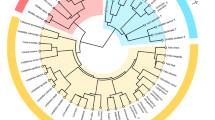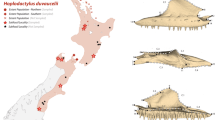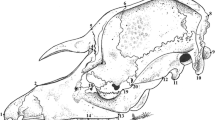Abstract
A geometric morphometric analysis was carried out on the crania of 13 species of elephant-shrews (Macroscelidea), a group of African mammals whose phylogeny is still debated. The material examined consisted of 313 crania and included all the genera of Macroscelididae, the unique family recognized by taxonomists. The results obtained from the analysis of the cranium shape and size, either from dorsal or lateral view, were very similar. The first one appeared more reliable because of the higher number of intersection points fixed between the cranial sutures. All the cranial features that distinguished the genus Rhynchocyon were a consequence of the extreme enlargement of frontal bones. Instead, within the subfamily Macroscelidinae, the differences between genera were based on modification involving other bones, mainly mastoids and nasals, as shown by the deformation grids. A cluster analysis confirmed the traditional subdivision in two subfamilies (Rhynchocyoninae and Macroscelidinae) but suggested a different relationship among the recognized genera belonging to Macroscelidinae. Our results are congruent with data obtained from previous biochemical research and support the traditional subdivision in two subfamilies, the monophily of the genus Elephantulus and its closeness with Petrodromus, relating to their similar cranium shapes. The latter presumably is a case of gigantism as adaptation to forest habitats. Further studies on all the species of Elephantulus could provide new evidence for assessing the relationships within this clade, including Macroscelides that by the present analysis appeared as a well-distinguished taxonomic entity.






Similar content being viewed by others
References
Adams DC, Slice DE, Rohlf FJ (2004) Geometric morphometrics: ten years of progress following the ‘revolution’. It J Zool 71:5–16
Asher RJ (1999) A morphological basis for assessing the phylogeny of the “Tenrecoidea” (Mammalia, Lipotyphla). Cladistics 15:231–252
Asher RJ, Novacek MJ, Geisler JH (2003) Relationship of endemic African mammals and their fossil relatives based on morphological and molecular evidence. J Mammal Evol 10:131–194
Barratt EM, Deaville R, Burland TM, Bruford MW, Jones G, Racey PA, Wayne RK (1997) DNA answers the call of pipistrelle bat species. Nature 387:138–139
Blacktith R, Reyment RA (1971) Multivariate morphometrics. Academic, New York
Bookstein FL (1991) Morphometric tools for landmark data. Cambridge University Press, Cambridge
Bookstein FL (1996) Standard formula for the uniform shape component in landmark data. In: Marcus LF, Corti M, Loy A, Naylor G, Slice D (eds) Advances in morphometrics. Plenum Press, New York, pp 153–168
Butler PM (1978) Insectivora and Chiroptera. In: Maglio VS, Cooke HBS (eds) Evolution of African mammals. Harvard University Press, Cambridge, pp 56–58
Butler PM (1995) Fossil Macroscelidea. Mammal Rev 25:3–14
Cardini A, O’Higgins P (2005) Post-natal ontogeny of the mandible and ventral cranium in Marmota species (Rodentia, Sciuridae): allometry and phylogeny. Zoomorphology 124:189–203
Caumul R, Polly PD (2005) Phylogenetic and environmental components of morphological variations: skull, mandible, and molar shape in marmots (Marmota, Rodentia). Evolution 59:2460–2472
Collard M, O’Higgins P (2001) Ontogeny and homoplasy in the papionin monkey face. Evol Dev 3:322–331
Collard M, Wood B (2001) Homoplasy and the early hominid masticatory system: inferences from analyses of extant hominoids and papionins. J Hum Evol 41:167–194
Corbet GB (1974) Family: Macroscelididae. In: Meester J, Setzer HW (eds) The mammals of Africa: an identification manual, part 1.5. Smithsonian Institution Press, Washington, DC, pp 1–6
Corbet GB (1995) A cladistic look at classification within the subfamily Macroscelidinae based upon morphology. Mammal Rev 25:15–18
Corbet GB, Hanks J (1968) A revision of the elephant-shrews, Family Macroscelididae. Bull Brit Mus Nat Hist 16:47–111
Delany MJ (1972) The ecology of small rodents in tropical Africa. Mammal Rev 2:1–42
Delany MJ (1974) The ecology of small mammals. Edward Arnold, London
Delany MJ, Happold DCD (1979) Ecology of African mammals. Longman Group, London
Douady CJ, Catzeflis F, Raman J, Springer MS, Stanhope MJ (2003) The Sahara as a vicariant agent, and the role of Miocene climatic events, in the diversification of the mammalian order Macroscelidea (elephant shrews). PNAS 100:8325–8330
Dryden IL, Mardia KV (1998) Statistical shape analysis. Wiley, West Sussex, England
Eisenberg J, Redford KH (1999) Mammals of the Neotropics, vol 3. The Central Neotropics: Ecuador, Peru, Bolivia, Brazil. The University of Chicago Press, Chicago and London
Gaudin TJ, Wible JR, Hopson JA, Turnbll WD (1996) Reexamination of the morphological evidence for the cohort Epitheria (Mammalia, Eutheria). J Mamm Evol 3:31–79
Hausser J (1984) Genetic drift and selection: their respective weights in the morphological and genetic differentiation of four species of shrews in southern Europe (Insectivora, Soricidae). Z Zool Syst Evol Forsch 22:302–320
Kendall DG (1984) Shape-manifolds, procrustean metrics and complex projective spaces. Bull Lond Math Soc 16:81–121
Kendall DG (1985) Exact distribution for shapes of random triangles in convex sets. Adv Appl Probab 17:308–329
Kingdon J (1974) East African mammals. Insectivores and Bats, vol IIA. University of Chicago, Chicago
Klingenberg CP (1998) Heterochrony and allometry: the analysis of evolutionary change in ontogeny. Biol Rev 73:79–123
Klingenberg CP, Barluenga M, Meyer A (2002) Shape analysis of symmetric structures: quantifying variation among individuals and asymmetry. Evolution 56:1909–1920
Kriegs JO, Churakov G, Kiefmann M, Jordan U, Brosius J, Schmitz J (2006) Retroposed Elements as archives for the evolutionary history of placental mammals. PLoS Biol 4(4):e91. doi:10.1371/journal.pbio.0040091
Lewontin RC (2000) The problems of population genetics. In: Singh RS, Krimbas CR (eds) Evolutionary genetics: from molecules to morphology. Cambridge University Press, Cambridge, pp 5–23
Madsen O, Scally M, Douady CJ, Kao DJ, De Bry RW, Adkins R, Amrine HM, Stanhope MJ, De Jong WW, Springer MS (2001) Parallel adaptative radiations in tw major clades of placental mammals. Nature 409:610–614
Malhotra A, Thorpe RS (1997) Size and shape variation in a Lesser Antillean anole, Anolis oculatus (Sauria: Iguanidae) in relation to habitat. Biol J Linn Soc 60:53–72
Marcus LF (1990) Traditional morphometrics. In: Rohlf FJ, Bookstein FL (eds) Proceedings of the Michigan Morphometrics Workshop. University of Michigan Museum of Zoology, Special Publication, pp 77–122
Mayer F, Helversen O von (2001) Sympatric distribution of two cryptic bat species across Europe. Biol J Linn Soc 74:365–374
McKenna MC (1975) Towards a phylogenetic classification of the mammals. In: Luckett WP, Szalay S (eds) Phylogeny of the primates: a multidisciplinary approach. Plenum Publishing, New York, pp 21–46
Meester JAJ, Rautenbach IL, Dippenaar NJ, Baker CM (1986) Classification of southern African mammals, vol 5. Transvaal Museum Monographs, Pretoria, pp 1–359
Meng J, Hu Y, Li C (2003) The osteology of Rhombomylus (Mammalia, Glires): implications for phylogeny and evolution of Glires. Bull Am Mus Nat Hist 275:1–247
Mitteroecker P, Gunz P, Bookstein FL (2005) Heterochrony and geometric morphometrics: a comparison of cranial growth in Pan paniscus and Pan troglodytes. Evol Dev 7:244–258
Murphy WJ, Eizirik E, Johnson WE, Zhang YP, Ryderk OA, O’Brien SJ (2001a) Molecular phylogenetics and the origins of placental mammals. Nature 409:614–618
Murphy WJ, Eizirik E, O’Brien SJ, Madsen O, Scally M, Douady CJ, Teeling E, Ryder OA, Stanhope MJ, De Jong WW, Springer MS (2001b) Resolution of the early placental mammal radiation using Bayesian phylogenetics. Science 294:2348–2351
Neal B (1995) The ecology and reproduction of the short-snouted elephant-shrew, Elephantulus brachyrhynchus, in Zimbabwe with a review of the reproductive ecology of the genus Elephantulus. Mammal Rev 25:51–60
Nicola PA, Monteiro LR, Pessôa LM, Von Zuben FJ, Rohlf FJ, Dos Reis SF (2003) Congruence of hierarchical, localized variation in cranial shape and molecular phylogenetic structure in spiny rats, genus Trinomys (Rodentia: Echimyidae). Biol J Linn Soc 80:385–396
Novacek MJ (1992) Mammalian phylogeny: shaking the tree. Nature 356:121–125
Novak RM, Paradiso JL (1983) Walker’s mammals of the World. John Hopkins University Press, Baltimore
O’Higgins P (1999) Ontogeny and phylogeny: morphometric approach to the study of skeletal growth and evolution. In: Chaplain MAJ, Singh GD, McLachlan J (eds) On growth and form: spatio-temporal patterning in biology, Wiley, London, pp 373–393
Patterson B (1965) The fossil elephant shrews (Family Macroscelididae). Bull Mus Comp Zool Harvard 133:295–335
Perrin MR (1995) The biology of elephant-shrews. Mammal Rev 25:1–100
Polly PD (2003a) Paleophylogeography of Sorex araneus: molar shape as a morphological marker for fossil shrews. Mammalia 68:233–243
Polly PD (2003b) Paleophylogeography: the tempo of geographic differentiation in marmots (Marmota). J Mammal 84:369–384
Raman J, Perrin MR (1997) Allozyme and isozyme variation in seven southern African elephant-shrew species. Z Saugetierkd 62:108–116
Rathbun GB (1979) The social structure and ecology of elephant shrews. Advances in Ethology, vol 20. Verlag Paul Parey, Berlin and Hamburg, pp 1–77
Rathbun GB, Fons R (1990) Modern elephant shrews. In: Grzimek B (ed) Grzimek’s encyclopedia of mammals, vol 1. McGraw-Hill, New York, pp 520–531
Roca AL, Bar-Gel GK, Eizirik E, Helgen KM, Maria R, Sprinter MS, O’Brien SJ, Murphy WJ (2004) Mesozoic origin for West Indian insectivores. Nature 429:649–651
Rohlf FJ (1993) Relative warp analysis and an example of its application to mosquito wings. In: Marcus LF, Bello E, Garcìa-Valdecasas A (eds) Contribution to morphometrics. Museo Nacional de Ciencias Naturales, Madrid, pp 131–159
Rohlf FJ (1998) On applications of geometric morphometrics to study of ontogeny and phylogeny. Syst Biol 47:147–158
Rohlf FJ (2001) TpsDig ver 1.31. Department of Ecology and Evolution, State of New York at Stony Brook, Stony Brook (NY)
Rohlf FJ (2002) TpsRelw. Department of Ecology and Evolution, State of New York at Stony Brook, Stony Brook (NY)
Rohlf FJ, Slice D (1990) Extentions of the Procrustes method for the optimal superimposition of landmarks. Syst Zool 39:40–59
Rohlf FJ, Loy A, Corti M (1996) Morphometric analysis of Old World Talpidae (Mammalia, Insectivora) using partial-warp scores. Syst Biol 45:344–362
Sarich VM (1993) Mammalian systematics: twenty-five years among their albumins and transferrins. In: Szalay S, Novacek MJ, McKenna MC (eds) Mammal phylogeny: placentals. Springer, New York, pp 103–114
Schlitter DA (1993) Order macroscelidea. In: Wilson DE, Reeder DM (eds) Mammals species of the world. Smithsonian Institution Press, Washington, DC, pp 829–830
Slice DE (1996) Introduction to landmark methods. In: Marcus LF, Corti M, Loy A, Naylor GJP, Slice DE (eds) Advances in morphometrics. Plenum Press, New York, pp 113–116
Slice DE (2001) Landmark coordinates aligned by Procrustes analysis do not lie in Kendall’s shape space. Syst Biol 50:141–149
Slice DE (2005) Modern morphometrics in physical anthropology. Plenum Press, New York
Slice DE, Bookstein FL, Marcus FL, Rohlf FJ (1996) A glossary of geometric morphometrics. In: Marcus LF, Corti M, Loy A, Naylor GJP, Slice DE (eds) Advances in morphometrics. Plenum Press, New York, pp 531–551
Smith KK (1997) Comparative patterns of craniofacial development in eutherian and metatherian mammals. Evolution 51:1663–1678
Smithers R (1983) The mammals of the Southern African Subregion. University of Pretoria, Pretoria, Republic of South Africa
Springer S, Cleven GC, Madesn O, De Jong WW, Amrine HM, Stanhope M (1997) Endemic African mammals shake the phylogenetic tree. Nature 388:61–64
Stanhope MJ, Waddell VG, Madsen O, De Jong WW, Hedges SB, Cleven GC, Kaoi D, Springer MS (1998) Molecular evidence for multiple origins of Insectivora and for a new order of endemic African insectivore mammals. Proc Nat Acad Sci USA 95:9967–9972
Stone KD, Cook JA (2002) Molecular evolution of holarctic martens (genus Martes, Mammalia: Carnivora: Mustelidae). Mol Phylogenet Evol 24:169–179
Straney DO, Patton JL (1980) Phylogenetic and environmental determinants of geographic variation of the pocket mouse Perognathus goldmani Osgood. Evolution 34:888–903
Tabuce R, Coiffait B, Coiffait PE, Mahboubi M, Jaeger JJ (2001) A new genus of Macroscelidea (Mammalia) from the Eocene of Algeria: a possible origin for elephant-shrews. J Vertebr Paleontol 21:535–535
Tolliver DK, Robbins LW, Rautenbach IL, Schlitter DA, Coetzee CG (1989) Biochemical systematics of elephant shrews from southern Africa. Biochem Syst Ecol 17:345–355
Van Dijk MAM, Madsen O, Catzeflis F, Stanhope MJ, De Jong WW, Pagel M (2001) Protein sequence signatures support the African clade of mammals. Proc Natl Acad Sci 98:188–193
Woodall PF (1995) The penis of elephant shrews (Mammalia: Macroscelidea). J Zool Lond 237:399–410
Zachos J, Pagani M, Sloan L, Thomas E, Billups K (2001) Trends, rhythms, and aberrations in global climate: 65 Ma to present. Science 292:686–693
Zack SP, Penkrot TA, Bloch JI, Rose KD (2005) Affinities of ‘hyopsodontids’ to elephant shrews and a holarctic origin of Afrotheria. Nature 434:497–501
Zelditch ML, Swiderski DL, Sheets HD, Fink WL (2004) Geometric Morphometrics for biologists: a primer. Elsevier Academic Press, New York and London
Acknowledgements
Thanks are due to the following museum curators who gave us assistance and help during our surveys: Theresa Kearney, curator of mammals at the Transvaal Museum (Pretoria, South Africa); Robert Asher, curator of mammals at the Museum für Naturkunde der Humboldt-Universität zu Berlin (Berlin, Germany); Paolo Agnelli, curator of Museo Zoologico La Specola, Università di Firenze (Florence, Italy). We are also grateful to Marco Bologna for the useful discussion and to Daniele Salvi who provided valuable help in the interpretation of biochemical data from literature. This study was supported by a grant from the project “Zoogeography of Mediterranean-southern African disjunct distributions by a multimethod approach” (Italian Ministry of Education, University and Research, n. 2004057217), coordinated by Prof. Marco A. Bologna, Roma Tre University, Department of Biology. We received also a financial support of the “European Commission’s Research Infrastructure Action via the SYNTHESYS Project”, thanks to which research in the Museum of Berlin was carried out by one of us (FP).
Author information
Authors and Affiliations
Corresponding author
Rights and permissions
About this article
Cite this article
Panchetti, F., Scalici, M., Carpaneto, G.M. et al. Shape and size variations in the cranium of elephant-shrews: a morphometric contribution to a phylogenetic debate. Zoomorphology 127, 69–82 (2008). https://doi.org/10.1007/s00435-007-0053-1
Received:
Revised:
Accepted:
Published:
Issue Date:
DOI: https://doi.org/10.1007/s00435-007-0053-1




